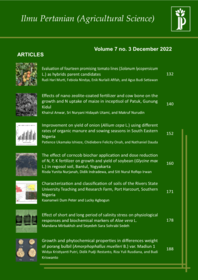Morphogenetic Variation of Shallot (Allium cepa L. Aggregatum Group)
Alfu Laila, Endang Sulistyaningsih, and Arif Wibowo(1*)
(1)
(*) Corresponding Author
Abstract
ABSTRACT
There are many shallot cultivars cultivated in Java with varying greatly morphological traits and yield. Morphological and yield variation indicate that there are genetic variation and varying in resistance to pest and disease. One of major disease that cause yield losses of shallot is Fusarium Basal Rot (FBR) caused by Fusarium oxysporum f. sp. cepae (Foc). The pathogen could cause yield losses of shallot in field up to 90%.
The number of sixteen shallot cultivars were collected and studied for determining polymorphisms of nuclear based on Random Amplified Polymorphism DNA (RAPD) and the morphological traits. Potted research was conducted at greenhouse from December to February 2012, in Department of Agriculture, Universitas Gadjah Mada (UGM), Yogyakarta. Four shallot cultivars were selected for study the response to Foc under biofertilizer application. They were Kuning, Trisula, Tiron, and Crok cultivars. The field experiment was carried out from June to August 2012 at the Agricultural Training, Research and Development Station (ATRD/KP4) in Kalitirto, Sleman, Yogyakarta. The research design was split plot 4 x 4, with three replications. The plots consisted of shallot which cultivated in Foc inoculation, biofertilizer application, combination of Foc inoculation and biofertilizer application, and without any treatments. The subplot consisted of shallot cultivars. All data were statistically analyzed using the variance analysis. Standard error was tested to determine the significant differences among treatment means.
Similarity coefficient among shallot cultivars as revealed by UPGMA cluster analysis of RAPD markers generated to molecular dendogram. The similarity of genetic dendogram ranged from 0.85 to 0.66 and separated of cultivars into two groups. Based on morphological analysis, there were variations of all variable that tested. Mophological dendogram made possible to identify four group.
Fusarium Basal Rot (FBR) incidence caused by seedborne was 6.94%. Biofertilizer application could not decrease significantly FBR incidence but it could increase number of bulb per plant in Crok and Kuning cultivars. FBR incidence with 43.75% caused by Foc inoculation was significantly decreasing plant height, number of bulbs, diameter of bulbs, and length of bulbs. However, yield of shallot decreased significantly from 1.05 kg/m2 to 0.63 kg/m2 when the shallot plantation was inoculated by Foc. The shallot plantation was inoculated by Foc under biofertilizer application did not show significantly decreasing FBR incidence and increasing the yield. FBR incidence and yield of Trisula, Crok and Tiron cultivars did not show difference significantly from Kuning cultivar as susceptible to Foc.
Key words: cultivar, shallot, RAPD, Fusarium oxysporum f. sp. Cepae (Foc), biofertilizerFull Text:
PDFArticle Metrics
Refbacks
- There are currently no refbacks.













